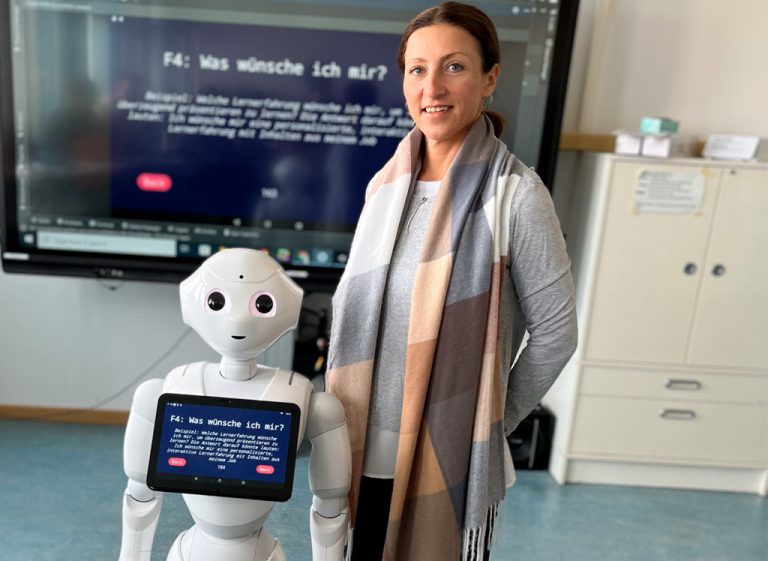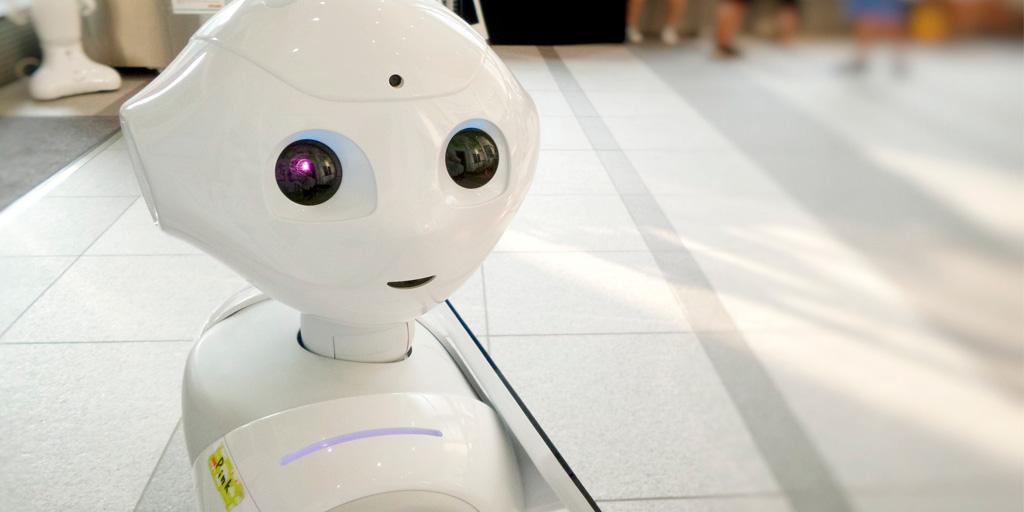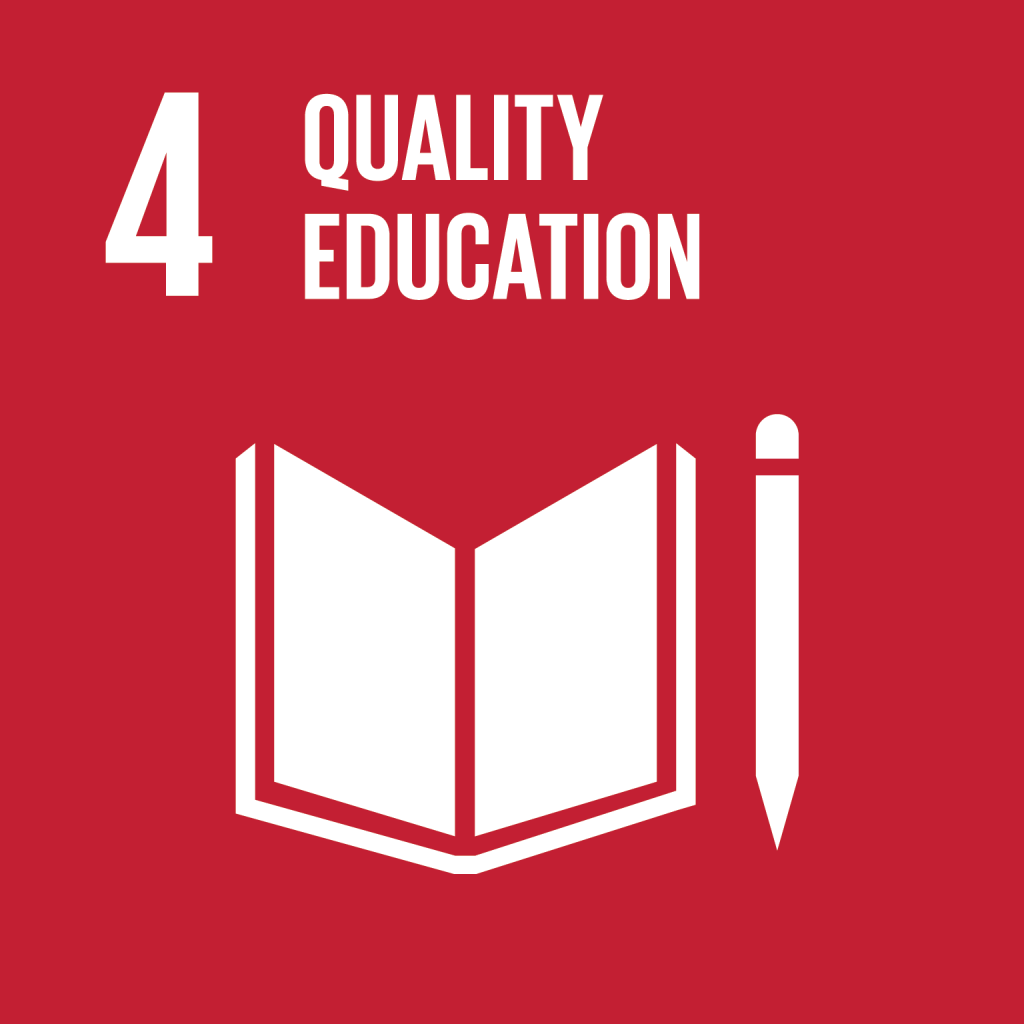Robotics and artificial intelligence (AI) in Education: using robots in the classroom. Interview with Professor Ilona Buchem (Part 2)
12 September, 2023 La professora Ilona Buchem amb el robot Pepper
La professora Ilona Buchem amb el robot PepperThe Educational Trends and Innovation Observatory at the eLinC interviewed Professor Ilona Buchem of the Berliner Hochschule für Technik (BHT, Berlin University of Applied Sciences and Technology), who talked about the different possibilities for using robots in the classroom. You can find out more about the benefits of AI in education and the future of robots in the first part of the article.
Professor Ilona Buchem teaches media and communication at the BHT in Berlin, where she is head of the Communications Lab. Her research and teaching focus on the interactions between information and communication technologies, digital media and society, and she actively works in the classroom with emerging technologies including robotics and gamification-based pedagogies. In this part of the interview, we talked about her experience using robots in the classroom.
The Pepper robot as an assistant in learning design
The communication lab led by Professor Buchem experiments with various robots. The basic idea is to study how robots can be applied in different roles in the classroom. The Pepper robot has been introduced to examine how a robot can support group work as part of a learning design course where students design applications for the use of robotics. The question they wanted to answer was how a robot can support teachers in a classroom with many students working in small groups, and how it can orchestrate an entire interactive session in a project-based workshop.
Features and benefits of using Pepper
One of Professor Buchem’s studies looks at an empathy mapping session. It is an interactive session, in which the students try to understand and empathize with the learner they are designing an e-learning program or application for. In this case Pepper orchestrates the class by introducing the session, explaining how it will be structured, what is going to happen, organizing the group discussions and transferring the conclusions to a panel. The robot also asks questions and measures response times, and even moves around the class, showing the question and an example on its tablet. Pepper assists Professor Buchem in these empathy mapping sessions at an organizational level. This gives her more time to deal with students in a personalized way, and means she does not have to think about timing. The support from the robot reduces the teacher’s stress levels in the classroom, and increases her well-being and satisfaction with the session.

Different uses for robots in the classroom
As shown in the example with the empathy mapping session, for Professor Buchem the robot can act as an assistant for teaching staff, helping to structure the class or providing support for the students. An example of this is the use of a smaller robot, such as NAO, on a desk to help the students at a more individual level in some lab sessions. Her unit is now working on a scenario in which a student has to teach the robot something. This means the student learns by teaching the robot to perform a task.
If we think of the classroom, the university or the school itself as a physical space, professor Buchem says that a robot can obviously also act as a concierge, perhaps at the entrance, to help students find a place in the room or find information, and welcome them.
Game-based learning and interaction with humanoid educational robots
Professor Ilona Buchem believes that most scenarios involving the use of robots contain some kind of game-based element, such as a feedback game in which the robot reacts to the students’ answers with a thumbs up or down, for example.
One of the projects she is involved in with her doctoral degree students is based on Pepper’s recognition of non-verbal sounds in the classroom. The background in this case is that many AI techniques are aimed at speech recognition and generation, but very little work has yet been done on non-verbal sounds, which are also very important in education. Ilona elaborates on this experience, and tells us that “as a teacher, for instance, in the classroom, you sense the atmosphere based not only on the verbal input of your students, but also based on the sounds they make: if they’re laughing, if they’re clapping, if there’s this type of sound, you know what’s going on”. So the first step in this process in this study has been to teach the robot to recognize simple mechanical sounds, such as the sounds of a buzzer, and it makes a note of the correct answers from two groups offered a series of questions. The next step will be to teach the robot to recognize different types of clapping and different sounds that express emotions.

Reflection
The introduction of educational and other types of family robots in teaching and learning processes has many dimensions. Apart from exploring the emotional aspects and helping teachers with various tasks, their intrinsically technological and cutting-edge nature mixed with the components of design, programming and gamification make robots the ideal vehicle for exploring the STEAM fields (science, technology, engineering, the arts, and mathematics).
Centres such as the Sant Joan de Déu Children’s Hospital have implemented pilot tests in which Pepper accompanies new patients upon their arrival at the centre, thereby complementing the instructions from the centre’s professionals and making the process more pleasant for the children and their families.
Something unthinkable a short time ago, such as the concept of ‘training a robot’ to act as a referee in an educational competition in the classroom is now a reality thanks to programming and the exponential growth of AI. There is no doubt that breakthroughs in this field such as machine learning and natural language processing will make robotics a discipline that is increasingly a focus of study, and it will make the transition from an idea to which non-specialist audiences cannot relate to a fact of life in a strikingly short time, including in the educational world.
This report supports United Nations Sustainable Development Goal (SDG) 4, Quality Education.




